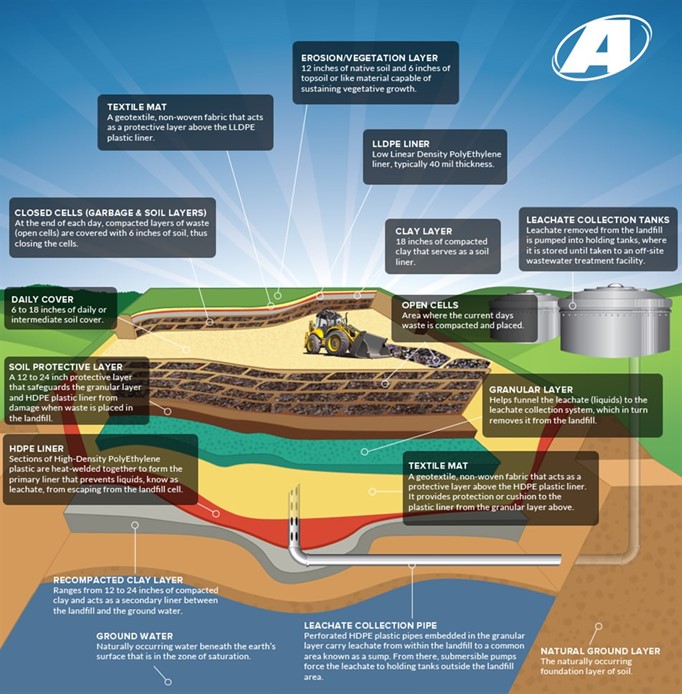The Complexity of Landfills
How Complex Landfills Have Become and Why They Have to Be
Cleaning out the garage? Take the trash to the dump. Landfill is the more sophisticated word for “the dump”. Mankind has been dumping garbage for as long as we’ve been making it. Ancient Rome had municipal waste collection. But the first modern day landfill was “constructed” in Fresno in the late 1930s. Yes, it wasn’t just a place to dump trash. It was built by design – engineered. However, some 20th century landfills were merely holes in the ground – those are real dumps!
The Solid Waste Disposal Act of 1965 governs waste disposal in the USA and requires each state to set waste management regulations. The Resource Conservation and Recovery Act (RCRA) sets the framework for the proper management of all types of solid waste. Subtitle D covers solid waste, Subtitle C hazardous waste. (This article will focus only on solid waste.)
Municipal Solid Waste Landfills (MSWLFs) accept household waste. A type of MSWLF that transforms and degrades organic waste is known as a bioreactor landfill. Another type of landfill is the industrial waste landfill. This is designed to collect commercial and institutional/industrial wastes, which is relatively significant from even the smallest communities. In this category, 2 types of landfills are recognized: 1) Construction and demolition debris landfill and 2) Coal combustion residual landfills (for ash). No matter the type of landfill, constant monitoring is required and must extend well beyond the waste site closure. This is to ensure safety in the surrounding environment for as long as necessary.
 It would be extremely easy to regurgitate how a landfill works, but here is a visual tool.1 Another well executed explanation was found in this YouTube video. Just over 8 minutes, it’s worth the time to view. One of the keys to the entire engineered process are the wells, pipes, and trenches used in the collection of the leachate and gas. As layers of garbage are piled, pressed, and covered, liquids leak and seep downward. Here’s an example to help you relate. When cooking in the kitchen small bits of garbage are collected. Maybe you’ve laid them on a paper towel with the intent to toss them in the trash, but you continue with the cooking, even eat the meal before returning to the small pile of garbage. Guess what? That paper towel has been soaking up the fluids that have leaked from the small bits of garbage. Landfills are similar. They collect all kinds of trash that is squished and pressed. Fluids flow downward. That fluid must go somewhere, and the collection pipes are the key.
It would be extremely easy to regurgitate how a landfill works, but here is a visual tool.1 Another well executed explanation was found in this YouTube video. Just over 8 minutes, it’s worth the time to view. One of the keys to the entire engineered process are the wells, pipes, and trenches used in the collection of the leachate and gas. As layers of garbage are piled, pressed, and covered, liquids leak and seep downward. Here’s an example to help you relate. When cooking in the kitchen small bits of garbage are collected. Maybe you’ve laid them on a paper towel with the intent to toss them in the trash, but you continue with the cooking, even eat the meal before returning to the small pile of garbage. Guess what? That paper towel has been soaking up the fluids that have leaked from the small bits of garbage. Landfills are similar. They collect all kinds of trash that is squished and pressed. Fluids flow downward. That fluid must go somewhere, and the collection pipes are the key.
Likewise, landfill gas (LFG) is a byproduct of leaching, creating leachate. Even with daily covering of the solid waste, when it rains the water filters through the waste. As it naturally flows downward it encounters buried waste and draws out, or leaches, chemicals and gases such as carbon dioxide and methane. These gases form within the cells or layers, in part, because there is no air or light. All U.S. landfills are required to collect LFG. Therefore, an important feature includes the wells, pipes, and trenches that collect the LFG. The gases travel upwards through the gas well line to the gas pump which pushes the gas to the flare, where gas is burned, converting the methane to carbon dioxide. This is the primary method for processing methane. The byproducts of burning methane for energy, which are C02 and H20, are less detrimental to the environment than allowing methane from landfill decomposition to escape naturally into the atmosphere. Alternatives methods for processing methane include converting LFG into usable energy. The usable energy can power industrial units like boilers or refined into renewable natural gas. Most often it is used to generate electricity. LFG-to-energy processes can capture 60% to 90% of the LFG from landfills!
Colorless, odorless, and invisible to the naked eye, methane is a potent greenhouse gas. It is responsible for more than 25 per cent of the global warming we are experiencing today. Due to its structure, methane traps more heat in the atmosphere per molecule than carbon dioxide (C02), making it 80 times more harmful than C02 for 20 years after it is released.
Cutting methane emissions by 45 per cent by 2030 could help us meet the Paris Agreement’s goal of limiting global warming to 1.5°C.
The energy sector (oil, gas, and coal) releases enormous amounts of methane into the atmosphere. The agriculture sector is also a major emitter, particularly from livestock such as cattle and cultivation of certain foods such as rice. Waste is the third most common man-made source of methane, as bacteria break down organic matter in landfills.
The good news is that since much of the methane release is caused by human activity, its reduction is considered the low hanging fruit of climate mitigation. The UN Environment Programme (UNEP) is at the forefront of the global effort to cut down on methane emissions.
Here is another interesting article….assuming we are all going to continue to enjoy or steak, eggs and bacon….Earth talk: Is methane capture from farms, ranches good for the environment? | Kidscontent | nny360.com
As it turns out, that hole in the ground is complex! Without the science and engineering aspects landfills would not be properly constructed. Without these elements landfills would be detrimental instead of being instrumental. With the conversion of methane to carbon dioxide to a renewable energy source, landfills are attempting to aid in the battle against C02 emissions. If methane were allowed into the air it would be much worse than burning it. Byproducts of the burn are C02 and H2O, which would enter the atmosphere and that's exactly what we want to reduce.
Efforts to manage landfills must continue to develop world-wide. Perhaps one of the most ironic factors in this topic is how plastic plays an extremely important role in making this system work. The HDPE and LLDPE liners used on the bottom of a landfill and each cell, as well as the HDPE pipes used throughout are key elements, too.
1 Image credit: Advanced Disposal as displayed here: How Sanitary Landfills Work - Earth911

